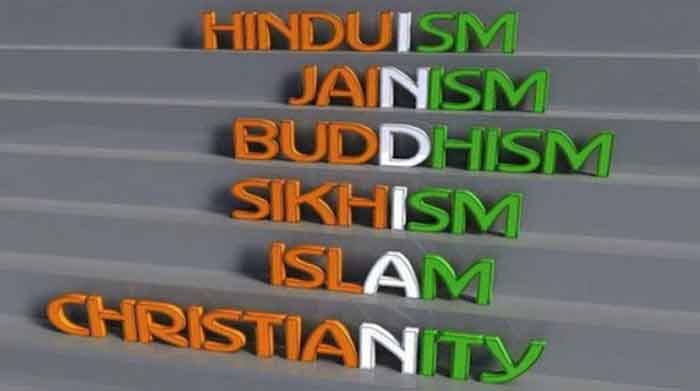
Sashi Tharoor pertinently observed: “While our mainstream media was distracted by hijab, halal, and azan, India’s labour force shrunk by 3.8 million in March. Unemployment rose across sectors.76 lakh jobs were lost in industry, 41 lakh in manufacturing, and 29 lakh in construction”. Communal riots had broken out in as many as four states including Delhi over last weekend. Violence has accompanied dozens of communal riots across the country over the fortnight and communal structures employ diversionary tactics.
In Goa, Chief Minister Sawant publicly declared that conversions are on the rise especially among vulnerable communities. Unaccompanied as they are by credible evidence, statements of this sort can only serve to build hate and construct aggression against minorities. A communal laboratory is at work across the country, discretely detailing patterns of communalism to adopt and transfer from one State to another. In contrast to the CM’s claim, the fact is that Christian numbers in Goa are in sharp decline and have been so for some decades now in real terms.
Writing back in 2008, Devika Sequeira notes that Catholics comprised a quarter of Goa’s population. The emigration rate within the community was 42 per cent for 100 households compared to just five percent among Hindus. Every third Christian home in Goa had an emigrant. That number has ostensibly seen a quantum leap by now. Bosco de Sousa Eremita, who has researched immigration and changing demographics in Goa, wrote in Union of Catholic Asian news Goa in 2015, that religion-based data for the 2012 census showed a minimal increase of 6,560 Christians over the previous ten years. Those figures concealed a negative Christian growth. Goa’s population had grown by eight percent in the previous ten years from 1.34 million to 1.45 million, while, in actual terms, the comparative growth should have produced at least 28,000 Christians. Clearly, there was downsizing of the Christian ratio even then. Although the 2010 statistics show Goan Christians with some 25 percent of the population, there is a steep decline of Christian presence. The downturn of Goa’s Christian population is no shocker. Even during the Portuguese colonial days (1510-1961) the slide was evident. Eremita cites how Catholics were 64 percent against 35 percent Hindus in the 1851 census. Today, Hindus make up 67 percent of Goa’s population, or more. Christians are probably less than even 25 percent owing to migration. Hindus opposed Portuguese attempts to force conversion in the 1540s and many migrated to settle in Karwar, Belgaum and Mangalore. Sequeira asserts: “Migration was preferred to abandoning traditional religious and cultural practices”.
When India annexed Goa in 1961, ending 450 years of Portuguese rule in this tiny coastal enclave, a major exodus of Christians followed. From 1961-63, around 50,000 Catholics emigrated. This emigration coincided with thousands of Hindus from neighboring states entering Goa. The continued migration saw a staggering escalation in the Hindu population. A quest for jobs abroad, augmented by Goan Catholics’ capacity for coping with overseas community conditions boosted emigration. It altered the balance of proportions in a big way. Today, every family probably has at least one person, or more, employed or settled overseas. Parents consciously encourage their children to emigrate. They perceive subtle discrimination and, cannot see a just and equitable future for Catholics in the state. The Portuguese constitution entitles every Goan born in Goa before Dec 19, 1961 or their descendants to Portuguese citizenship.
The assumption of power in Goa by the BJP has further spiked immigration trends. The rebuff of a statue to honour to Jack Sequeira has caused Christians to wonder if this is part of the subjugation of Christians. He won Goans the ‘Opinion Poll’ which has enabled the fact of a Goan entity. Catholics are often identified as “Portuguese agents” despite their contribution to the freedom struggle and to everyday economics, politics, and civil society. Agricultural reforms in Goa made tillers landowners, but Catholic landlords were often rendered landless and reduced to penury.
To even infer that Hindus are under threat from conversions lacks social logic. Christians are not foreigners who live in India. They feel the soil of Goa as their own and will give their all to protect Goa. Moreover, the church in Goa is not expansionist in evangelical terms. Every parish is active and replete with institutions and activities. Churches and the Religious pan out into remote areas to serve the least and last in society. They are the largest provider of child-related services to the disadvantaged. Christians promote education for all and to the elderly, differently-abled, vulnerable women, and other categories of socially excluded. All of this is done without barriers of religion, caste and class. Forcible and induced conversions create communal passions and breach public order. This includes the euphemistic notion of ‘Ghar Wapsi’ which, in essence, is an anti-minority construct of prevailing communal structures. If the CM’s attempt is to test the waters of whether a conversion law is feasible in Goa, he is seriously miscalculating social facts and Christian loyalties. It is a fact that India is the most dangerous place for Christians.
Article 25 of the Constitution guarantees the freedom of conscience and religion to all persons and the right to freely profess practice and propagate religion, subject to public order. Beyond this every individual has the right to keep one’s beliefs undisclosed. In the ideal world, we do best when we follow the ideal to let a Hindu be a good Hindu, a Muslim remain a loyal Muslim, a Christian practice their faith without hindrance, a Sikh pursue their religious path, and a Buddhist their spiritual pathway. After all, do not all the major world religions converge on how we identify with the spiritual quest, the path of discipleship and holiness, and a common humanity?
Ranjan Solomon is a political commentator, human rights activist, and has written about and organized inter-religious fora.
Originally published in The Goan











































